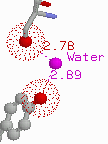

It is important to realize, however, that the basic scientific understanding of intermolecular interactions is still rather primitive. The ab initio prediction of the binding constant of a compound to a protein molecule is, in general, still far beyond current computational techniques and biophysical scientific precision, in large part because of the ubiquitous effects of water. Water molecules confound ab initio predictions in several ways;
- they compete with hydrogen bond donors and acceptors of both protein and ligand; they can mediate hydrogen bonds;
- they provide a large electrostatic screening effect;
- they are involved in van der Waals interactions with protein as well as inhibitor;
- they are the root cause of hydrophobic effects, the fundamental nature of which is still under considerable debate.
A second problem is the correct description of the charge distribution on protein and ligand. Not only is it difficult to arrive at 'true' partial atomic charges but, due to polarization effects, the charge distribution of a ligand is different in solution from that seen when it is bound to a protein molecule. In addition, there is the problem of flexibility - of both protein and ligand - so that the configuration space that is accessible to the molecular system is so large that it becomes difficult to generate a representative ensemble necessary for the calculation of free energies.
Our imperfect understanding of intermolecular interactions coupled with the large number of degrees of freedom, makes it crucial that the protein structure-based drug design process be a tightly integrated, multidisciplinary activity where the intuition of the medicinal chemist is combined with the expertise of the protein structure specialist and the computational molecular modeler.